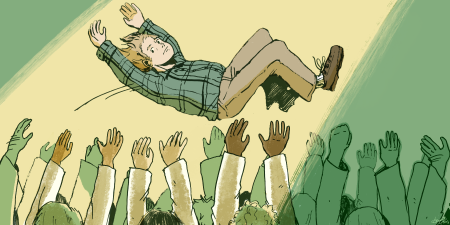When it comes to patient placement, we often avoid explicit use of derogatory terms like turfing or pawning, which both mean that one health care team places a patient with another team rather than taking care of the patient themselves. Perhaps we often don’t talk about patient placement at all because we wish to avoid our roles in its ethical troubles and because we tend to divert attention from what turfing and pawning might suggest about our characters. A literature search on patient placement will bring up few literature reviews or even policy articles about what is one of the most significant and ethically relevant problems in US health care, which will, without changes, only be exacerbated as our population ages and requires more care.1,2,3,4
Turfing’s ethical problems tend to be expressed as responsibility avoidance or as a failure to define a patient’s belonging in our own professional “circle of human concern.”5 It is systemic and can be traced throughout all veins of the US health care system. In outpatient settings, some physicians choose to refuse to see patients covered by Medicaid,6,7 although the Medicaid program supports graduate medical education.8 Additionally, as physicians become more subspecialized, a patient might be sent to multiple subspecialists, creating difficulties for patients trying to manage their multimorbidity, while their primary care physician—under billing and insurance pressures—might only have 10 minutes to try to respond to their needs or address their concerns.9,10
Moreover, as the emergency department (ED) has become the safety net of America, it has increasingly become a site of turfing. When patients don’t understand where to go, when waiting times to see a specialist are several weeks,11 when their insurance is not accepted elsewhere, or when they are uninsured, patients know that they can come to the ED, where everyone will be seen.12,13 The accessibility of the ED, of course, creates long waiting times, even though emergency medicine physicians try their best to triage patients by the severity and urgency of their health problems. They treat what they can and refer what they can’t treat to outpatient physicians, but what about the patients who have difficulty following up and who return to the ED again for the same problem?
Not every problem can be resolved in the ED or referred to outpatient follow-up, as some patients require admission, creating yet another moment of patient placement conflict.1,2,3,4 Questions such as the following are considered in this theme issue: Should a patient with a broken hip go to medicine, which must also manage perioperative care, or to orthopedics, which must also manage that patient’s general medical care? Is a patient sick enough for intensive care or well enough for floors? Which team should be regarded as “in charge” of a patient and which team should be regarded as “consulting”? Conflicting views of what’s best for a patient generally need to be negotiated collaboratively in order to avoid the harms of turfing and to maintain a patient’s faith that their caregivers are acting together to promote the best care and to express professionalism and collegiality.
Upon discharge, all problems about where patients should be seen as belonging are not solved. In a country that seems to have a perpetual and worsening staffing shortage and therefore decreased patient capacity at nursing homes, rehabilitation facilities, and assisted living facilities, figuring out where and how to place a patient who needs extra help after discharge may be difficult.14 Some patients have to wait for days until a proper facility placement is found, and, in the meantime, they occupy hospital beds that they do not need anymore.4 This backup on the floors adds to the notoriety of boarding problems in EDs,15,16 with patients in hallway beds as they await admission to an appropriate location where they will receive indicated care.
The prevalence and problematic nature of turfing—essentially, poorly executed placement decisions—makes it a ripe topic for ethical discussion. Should physicians have the right to avoid patient care by forcefully handing over care to someone else? Should patients be seen as benefiting from being out of the care of a team that does not want them? Fighting over who “has to” take care of a patient is thus detrimental to interdisciplinary and interspecialty relationships. More generally, a negative work environment in which clinicians are overworked and lack control over aspects of their work lives can lead to increased fatigue and burnout.17 A toxic culture of classifying patients as “turfable” or undesirable is not sustainable for the well-being of either health care workers or patients.
Although entrenched practices can be hard to address or root out, turfing is long overdue for change. Change starts by clinicians and administrators having a candid discussion about turfing’s ethical and legal implications as well as by making workplace cultural shifts (including improving interdisciplinary communication, focusing on patient-centered rather than disease-centered care, and bringing humanity into our discussions with each other and with patients) and implementing policies that could turn arguments about patient turfing into humane discussions about proper patient placement.
References
- Stern DT, Caldicott CV. Turfing: patients in the balance. J Gen Intern Med. 1999;14(4):243-248.
- Caldicott CV, Dunn KA, Frankel RM. Can patients tell when they are unwanted? “Turfing” in residency training. Patient Educ Couns. 2005;56(1):104-111.
- Caldicott CV. Turfing revisited. Virtual Mentor. 2012;14(5):389-395.
- Roberts DE, Holloway RG, George BP. Post-acute care discharge delays for neurology inpatients: opportunity to improve patient flow. Neurol Clin Pract. 2018;8(4):302-310.
- powell ja, Toppin E Jr. Health equity and the circle of human concern. AMA J Ethics. 2021;23(2):E166-E174.
- Bhandari N, Shi Y, Jung K. Patient experience of provider refusal of Medicaid coverage and its implications. J Health Care Poor Underserved. 2016;27(2):479-494.
-
Hsiang WR, Lukasiewicz A, Gentry M, et al. Medicaid patients have greater difficulty scheduling health care appointments compared with private insurance patients: a meta-analysis. Inquiry. 2019;56:46958019838118.
-
Council on Legislation; Council on Medical Education. 2020 Compendium of graduate medical education initiatives report. American Medical Association; 2020. Accessed July 26, 2023. https://www.ama-assn.org/system/files/2020-08/2020-gme-compendium-report.pdf
-
Anderlini D. The United States health care system is sick: from Adam Smith to overspecialization. Cureus. 2018;10(5):e2720.
-
Wallace E, Salisbury C, Guthrie B, Lewis C, Fahey T, Smith SM. Managing patients with multimorbidity in primary care. BMJ. 2015;350:h176.
-
AMN Healthcare; Merritt Hawkins. 2022 Survey of physician appointment wait times and Medicare and Medicaid acceptance rates. AMN Healthcare; 2022. Accessed July 28, 2023. https://www.merritthawkins.com/uploadedFiles/MerrittHawkins/Content/News_and_Insights/Articles/mha-2022-wait-time-survey.pdf
-
Selby S, Wang D, Murray E, Lang E. Emergency departments as the health safety nets of society: a descriptive and multicenter analysis of social worker support in the emergency room. Cureus. 2018;10(9):e3247.
-
Gorodetzer R, Alpert EA, Orr Z, Unger S, Zalut T. Lessons learned from an evaluation of referrals to the emergency department. Isr J Health Policy Res. 2020;9(1):18.
-
Moe A. The crisis facing nursing homes, assisted living and home care for America’s elderly. Politico. July 28, 2022. Accessed January 12, 2023. https://www.politico.com/news/magazine/2022/07/28/elder-care-worker-shortage-immigration-crisis-00047454
-
Laam LA, Wary AA, Strony RS, Fitzpatrick MH, Kraus CK. Quantifying the impact of patient boarding on emergency department length of stay: all admitted patients are negatively affected by boarding. J Am Coll Emerg Physicians Open. 2021;2(2):e12401.
-
Boudi Z, Lauque D, Alsabri M, et al. Association between boarding in the emergency department and in-hospital mortality: a systematic review. PLoS One. 2020;15(4):e0231253.
- West CP, Dyrbye LN, Shanafelt TD. Physician burnout: contributors, consequences and solutions. J Intern Med. 2018;283(6):516-529.



